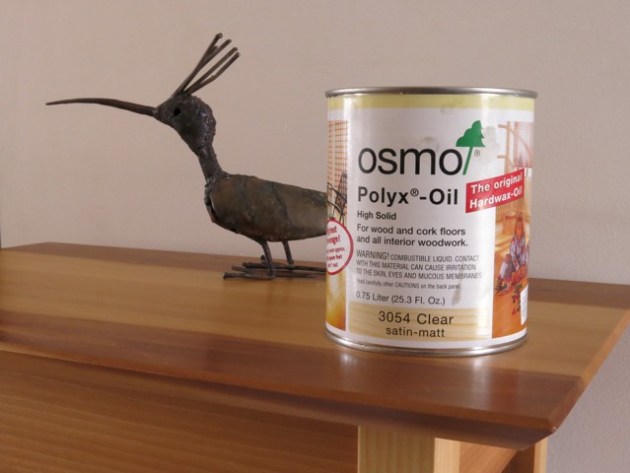About two years ago, I hatched an evil scheme: I intuited that Chris would be writing about polissoirs within the next six months. I also figured that he would eventually invite me to write on his blog. And so I slipped him a small mahogany board that I had finished to look like it had been polissoir-ed, but was in fact finished using more modern techniques. Last week, my plans finally came to fruition, as he mistakenly put forth my sample board as an example of polissoir-ization. It was all very reminiscent of Armand LaMontagne’s Brewster Chair.
Actually, it didn’t go down quite like that, and I apologize for inadvertently leading Chris astray. The irony is that I really did give him the board because I thought that the finish I used looks a lot like a polissoir-ed finish, but I didn’t intend for him to get his boards mixed up.
So what is this miracle finish? It’s something that you’ve probably never heard of: Polyx-Oil, from Osmo (a German manufacturer of wood flooring and wood-finishing products). Polyx-Oil is one of a number of finishes known as hardwax oils. As the name suggests, hardwax oils are a blend of a hard wax (typically candelilla and/or carnauba) and a drying oil (soy, tung, linseed, etc.). Hardwax oils have become popular in Europe in recent years, but they’re still relatively unknown in North America. Until very recently, the only products imported to the U.S. were those from Osmo, but some of the other manufacturers have started to show up. My experience is only with the Osmo products, so from now on that’s what I’ll be talking about. There’s a list of Osmo dealers available on their web site (you can also buy through the company named after a mythical female warrior nation).
While Polyx-Oil hardly qualifies as a Lost Art, it’s interesting that it really isn’t that different from old-time finishes: just oil, wax and a pinch of drying agent. It would seem that much of modern finish chemistry uses the same materials as always, and that the main differences are in molecular micromanagement.
Polyx-Oil was originally developed as a finish for wood floors. While neither “Foolproof!” nor “The Last Finish You’ll Ever Need!” it is easy to use and does a good job of protecting wood against everyday spills and such, but it isn’t truly waterproof. I think it’s fine for most furniture, with the possible exception of dining tables. I wouldn’t use it on bathroom cabinets, and I’d think twice about it on kitchen cabinets. It’s also not recommended as a finish for oily tropical woods. (Osmo recommends against using it on mahogany, but I haven’t experienced any problems with either real mahogany or its African relatives.)
Osmo makes three variations of Polyx-Oil, the original Polyx-Oil, Top Oil and Polyx Pro Oil. All three are very similar, with the only significant difference being the amount of solvent. Top Oil contains more solvent, and is supposedly optimized for furniture and countertops (as opposed to floors). Polyx Pro Oil contains virtually no solvent, for situations that call for a very low-VOC finish.
I’ve used both original Polyx-Oil and Top Oil, and have to say that if there is a difference, it’s hardly noticeable. Top Oil does come in a container with a screw top, making it a bit more convenient for touch-ups. I haven’t tried Polyx Pro Oil, mainly because it only comes in very large containers and is therefore rather expensive.
Through trial and error, I developed a finishing schedule that deviates from the Osmo instructions but is well suited to furniture and casework. The resulting finish is silky and semi-matte. It looks and feels like paste wax over oil, but is more durable. You can download a PDF of my finishing schedule here.

–Steve Schafer